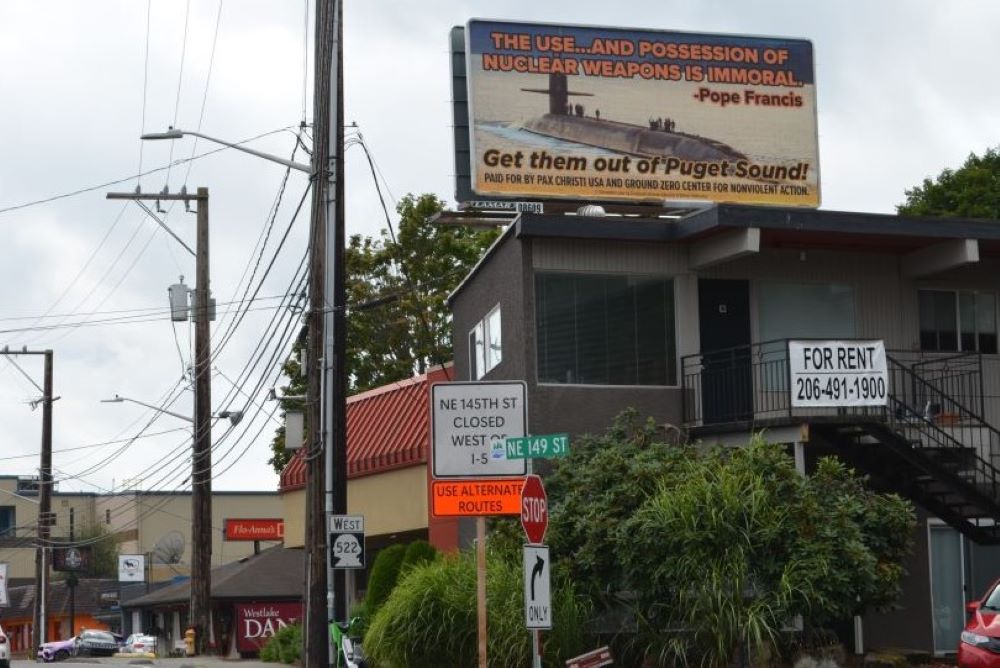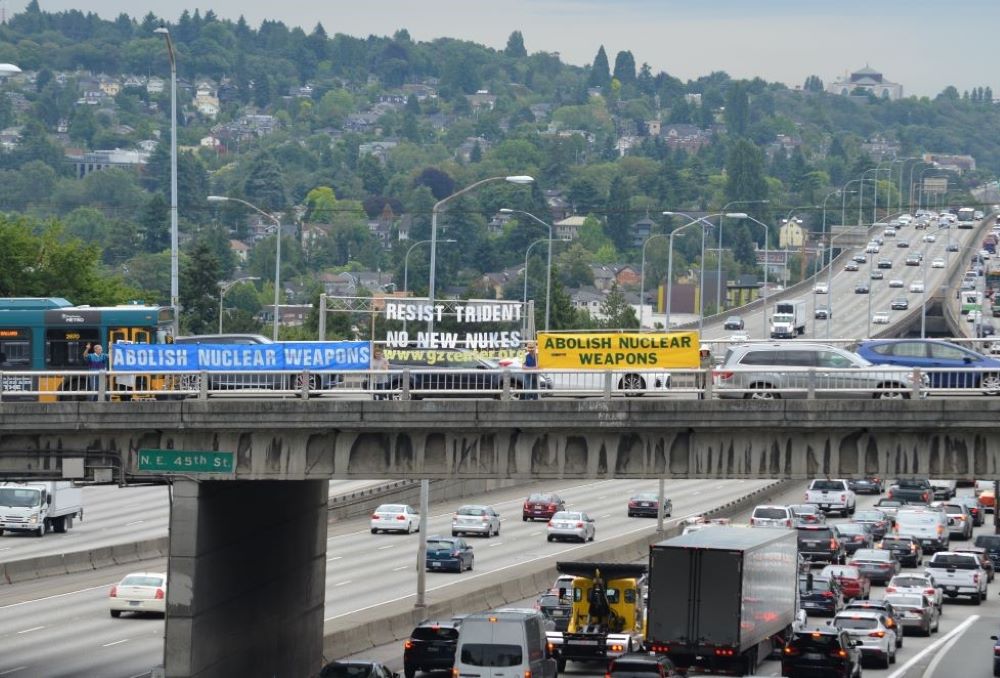
Rodney Brunell, a member of Pax Christi, participates aboard his kayak in a "peace flotilla" to protest nuclear weapons near Naval Base Kitsap-Bangor in 2016. For decades a group of activists has held peaceful demonstrations at the base, not far from downtown Seattle and home to a fleet of eight Ohio-class nuclear attack submarines. (Courtesy of Rodney Brunell)
Less than 30 miles from bustling Pike Place Market and the many coffee shops of downtown Seattle is one of the world's largest concentrations of deployed nuclear weapons.
Naval Base Kitsap-Bangor, west of the city across Puget Sound, contains warheads whose estimated explosive force is thousands of times greater than the bomb dropped on Hiroshima, Japan.
Since the submarine base was activated in 1977, nonviolent activists, including Catholics, have used banners and boats, civil disobedience and prayer to protest the weapons and educate the public about their presence.
This year, however, they received some special assistance: approval from the Vatican to use the words of Pope Francis.
Pax Christi USA, the Catholic peace movement, and the nonprofit Ground Zero Center for Nonviolent Action purchased five billboards to run four weeks in the Seattle region. Displayed through mid-September, the signs were designed by Pax Christi members in the Pacific Northwest and draw from a 2019 address the pope gave in Hiroshima.
"The use … and possession of nuclear weapons is immoral," state the billboards, which feature a photo of one of the naval base's eight weapon-bearing submarines.

One of five billboards purchased by Pax Christi USA and Ground Zero Center for Nonviolent Action hangs in Lake Forest Park, northeast of Seattle. The two groups purchased five billboards, which draw on Pope Francis' 2019 address in Hiroshima, Japan. (Courtesy of Glen Milner)
Rodney Brunell, a longtime antinuclear activist and member of Pax Christi, told NCR some people in the area know about the nuclear weapons, but many do not.
"We want to make sure they are informed," he said. "My belief in the way of Jesus is that nuclear weapons and wars are simply not compatible with the Gospel."
The atomic bomb the U.S. dropped on Hiroshima Aug. 6, 1945, had an explosive yield of about 15 kilotons; the U.S. detonated a 21-kiloton bomb over Nagasaki Aug. 9. Together they killed approximately 200,000 people, with many more dying years later from radiation poisoning and cancer linked to the bombings.
Denny Duffell is a permanent deacon in the Seattle Archdiocese and regional coordinator of Pax Christi Northwest. (Courtesy of Denny Duffell)
By comparison, each submarine at the Kitsap-Bangor base carries an estimated 90 nuclear warheads, and most warheads are either 90 kilotons or 455 kilotons, according to the Bulletin of the Atomic Scientists. A journal and a nonprofit, the bulletin was founded in 1945 by scientists who worked on the first atom bomb.
"We've got to get rid of nuclear weapons before they get rid of us," said Denny Duffell, a permanent deacon in the Seattle Archdiocese and regional coordinator of Pax Christi Northwest. "We have no right to threaten to use these to kill millions of people, maybe billions."
They are a smaller, older group than in years past, but antinuclear advocates in the Pacific Northwest remain resolute in their decadeslong effort. They have coordinated blockades near the base, handed out countless leaflets and stood bearing banners that read "no new nukes" and "abolish nuclear weapons" on freeway overpasses. Many have been arrested numerous times.
Antinuclear activists also have held "peace flotillas" along the Bangor waterfront, where Trident missiles armed with warheads are loaded onto submarines and the subs are resupplied for patrols in the Pacific Ocean.
A flotilla was held Sept. 4, organized in part by the group Veterans for Peace. Although the turnout was more modest than in the past, the flotilla featured a boat called the Golden Rule, a vessel that first set sail in 1958 in an attempt to stop the United States from testing nuclear weapons in the Marshall Islands. The impact of the tests was significant, displacing Indigenous inhabitants and spreading cancer-causing radiation.

Most Fridays during the summer, a group that includes members of Pax Christi drapes banners over an Interstate 5 overpass in Seattle, calling attention to the nearby arsenal of nuclear weapons. Naval Base Kitsap-Bangor holds one of the world's largest concentrations of deployed nuclear weapons. (Courtesy of Rodney Brunell)
More than 40 years ago, in 1982, the inaugural water-based antinuclear witness near the Washington state base convened when the first Ohio-class ballistic missile submarine, the USS Ohio, approached its homeport and a flotilla of small sailboats and rowboats attempted to blockade the sub with nonviolent resistance. The group was apprehended by the Coast Guard, which sprayed a fire hose on one boat and arrested more than a dozen protestors.
Over the years, priests and women religious joined antinuclear efforts at Bangor, including Dominican Sr. Jackie Hudson, who served time in federal prison for pouring her blood on a missile silo in Colorado. Prior to the first flotilla, Seattle Archbishop Raymond Hunthausen, an outspoken critic of the United States' nuclear buildup, blessed the boats. The prelate, who died in 2018, angered many in the church for his views on issues including gay rights and women in leadership, but he is most well-known for his forceful condemnation of nuclear weapons.
The commitment of Hunthausen and others "remains in our hearts as an inspiration for our continued work for peace," said Glen Milner, a member of Ground Zero. Advocates in the region are also inspired by the current Seattle archbishop, Paul Etienne, he added.
Last year Etienne and Archbishop John Wester of Santa Fe, New Mexico, participated in a "Pilgrimage of Peace" to Japan, where the church leaders promoted nuclear disarmament. On the one-year anniversary of the trip in August, Etienne reaffirmed the call for nuclear disarmament in a letter to local Catholics.
"The devastation — physical, emotional, ecological — from these two primitive nuclear bombs was truly horrific," wrote the archbishop. "Knowing that we continue to manufacture these weapons, refining their destructive power, is beyond alarming."

Pope Francis participates in a moment of silence during a meeting for peace at the Hiroshima Peace Memorial in Hiroshima, Japan, Nov. 24, 2019. In an address that day, he called nuclear weapons "a crime not only against the dignity of human beings but against any possible future for our common home." (CNS/Paul Haring)
Wester, along with Cardinal Robert McElroy of San Diego and other bishops, attended a Sept. 7 forum in New Mexico that gave religious leaders and activists an opportunity to discuss nuclear disarmament and deterrence.
Nuclear deterrence is a theory that's long been central to America's security policy and contends adversaries will be deterred from launching an attack because it would risk a devastating counterattack.
Pope Francis has departed from his predecessors by unequivocally condemning the possession and use of nuclear weapons.
In 2023, Ground Zero, which for several years ran billboards and bus advertisements highlighting the nearby presence of nuclear warheads, partnered with Pax Christi on the billboards, and this year the groups were eager to use a statement from the pontiff.
'We've got to get rid of nuclear weapons before they get rid of us.'
—Denny Duffell
They encountered a glitch, though,when the billboard company insisted that "because we are quoting the pope, we had to get his permission," Duffell told NCR. "There was some back and forth, but the company was not going to budge." Members of Pax Christi and Ground Zero were unsure how to proceed.
As the deadline approached to sign the billboard contract, a Seattle archdiocesan official suggested they contact the Vatican Publishing House, a part of the Dicastery for Communication that oversees copyrighted material.
Approval was granted quickly, to the relief and delight of the organizers. "We all can get on with our work, knowing the Pope is with us," wrote Duffell in an email to fellow activists.
Advertisement
Though the United States dramatically reduced its stockpile of nuclear weapons over the past 50 years, it continues to modernize its arsenal. Between 2023 and 2032, the U.S. Department of Defense and Department of Energy will spend some $756 billion on nuclear forces, according to budget projections from the Congressional Budget Office.
The only remaining nuclear arms control treaty between Russia and the United States, the New START treaty, is set to expire in 2026, and Russian President Vladimir Putin already suspended his country's participation last year.
Taking into account the wars in Ukraine and the Middle East, as well as climate change and the risks of artificial intelligence, the Doomsday Clock is set to a mere 90 seconds to "midnight," the symbolic hour of the apocalypse. The metaphorical clock was created in 1947 by the Bulletin of the Atomic Scientists and previously ranged from 3 minutes to 17 minutes.
"With increased threat of nuclear war, we are seeing fewer and fewer citizens with any knowledge of the submarine base in our region," Milner said. "And fewer citizens even think of the possibility of nuclear war."
Yet with inspiration from Catholic leaders and the statement of Pope Francis on the billboards, "we hope to start a discussion," he said.
"I don't know how the Holy Spirit is going to move us," added Duffell, who'd like to see the billboard campaign continue next year. "But I'm very hopeful about the power of the Holy Spirit going forward in this work."








